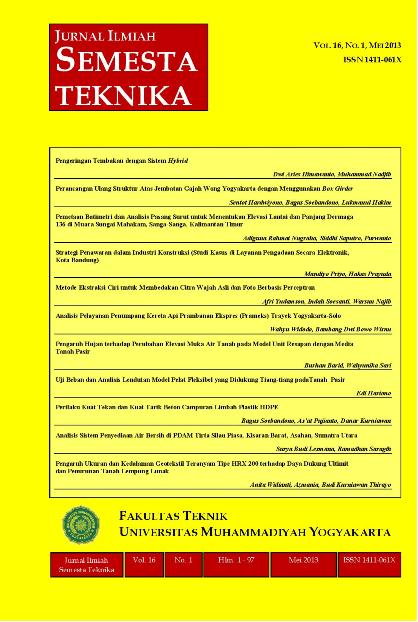Uji Beban dan Analisis Lendutan Model Pelat Fleksibel yang Didukung Tiang-Tiang pada Tanah Pasir
DOI:
https://doi.org/10.18196/st.v16i1.434Abstract
Sand commonly has a good bearing capacity. Problems may occur when sand has low density and thick deposit. Flexible plate foundation may be used in this soil but plate deflection may be still high. To reduce deflection and improving soil density, piles were used to support the plate. Installing piles made foundation system stiffer. The objectives of this study are to studies about behavior of plates and plate with a pile of sand on the ground, influence of plate thickness , pile length and spacing of the pole deflection, and the influence of the bond between the plate and the deflection of the pile .In this study is used test box of 1.2 m depth, 1.2 m width, 1.2 m length, and 1.0 m depth filled out with sand. Plate models were made from plexiglas of rectangular and square geometry. Piles were of steel pipesof 2.5cm diameter. Some parameters were as follows : plate thickness, plate geometry, pile length (L), pile spacing (s), bounding between plate and pile (fix or free), ’piled’ and freestanding foundation, and base pile enlargement. The behavior of the plateswere observed under loading (point load). The result shows that plate deflections were affected by the method of pile installation, plate thickness and pile length. For a ticker plate, contact surface between plate and soil was wider. For the 40cmx10cm plates with fix end pile, deflectionswere founf to reduced up to 70% compared with free end pile. The ’piled foundation’ on 40cmx10cm plates, L=20cm, s=4d, deflections were reduced 83,63% compared with free standing foundation.
Downloads
Published
How to Cite
Issue
Section
License
Semesta Teknika is licensed under a Creative Commons Attribution 4.0 International License.
Authors who publish with this journal agree to the following terms:
- Authors retain copyright and grant the journal right of first publication with the work simultaneously licensed under a Creative Commons Attribution License that allows others to share the work with an acknowledgement of the work's authorship and initial publication in this journal.
- Authors are able to enter into separate, additional contractual arrangements for the non-exclusive distribution of the journal's published version of the work (e.g., post it to an institutional repository or publish it in a book), with an acknowledgement of its initial publication in this journal.
- Authors are permitted and encouraged to post their work online (e.g., in institutional repositories or on their website) prior to and during the submission process, as it can lead to productive exchanges, as well as earlier and greater citation of published work (See The Effect of Open Access).









